RL is a relatively new branch of logistics sector. Therefore, it is, first and foremost, essential to define it and distinguish from traditional logistics. One of the rationales for reviewing the existing definitions is that they provide a clue to understanding the key functions of modern RL and their transformation throughout the time. Thus, according to Christiansen (2014), the first attempts to introduce the notions associated with reverse logistics date back to the 1970s when such terms as “reverse channels” and “reverse flows” would first appear in the relevant research (p. 157).
Later on, in the 1980s, Murphy (1986) introduced a new concept – “reverse distribution” – that was mainly associated with transporting and warehousing operations. At that point, RL would be outlined more precisely – due to Carter and Ellram (1998), it acquired a new definition, according to which RL was interpreted as “a process whereby companies can become more environmentally efficient through recycling, reusing, and reducing the amount of materials used” (p. 85). Therefore, it might be concluded that RL was initially perceived as a way to enhance the principles of the green and environmentally healthy market, while the potential economic advantages were evidently underestimated.
Gradually, companies would realize the financial prospects of RL activities, so that a more modern interpretation of RL proposed by Thierry, Salomon, Van Nunen and Van Wassenhove (1995) would align RL with minimizing the cost of product and material flows as well as raising their efficacy. This interpretation would add a new implication to the RL’s core function – this branch targeted not only to make logistics more sustainable but to reduce the disbursements and make the entire process cost-effective. Their definition is very similar to the modern interpretation of the term. Thus, nowadays, RL is regarded as a complementing element of traditional logistics that is mainly aimed at adding value to its objectives through such operations as remanufacture, recycle, and disposal (Christiansen, 2014). As a consequence, it might be concluded that RL is a set of effective tools that help to improve the quality of supply chain management (SHM) and optimize the flows of products and materials.
The review of RL definitions also helps to point out the directions of the product and material flows. Hence, for instance, according to Rogers and Tibben-Lembke (2001), RL essentially implies managing the key elements of supply chain such as raw materials and finished goods “from the point of consumption to the point of origin for the purpose of recapturing or creating value or for proper disposal” (p. 132).. Yet, the definition is too general – it fails to define the particular start and finish points.
Likewise, Ritchie, Burnes, Whittle and Hey (2000) are not thoroughly specific in their definition, noting that reverse logistics includes not only the process of goods delivery to target customers, but also the process of returning them to suppliers through the relevant feedback loop. Meanwhile, their definition provides some additional insights on the RL actors: the authors introduce the third element of the RL chain – feedback loops. Even though the researchers provide no clarifications regarding the point of origin or the point of consumption in the context of the modern reality, it might be assumed these points imply not only the essential consumer but secondary markets and other outlets as well. As a result, these definitions help to generate the understanding of the key destinations of the product flow and the scope of the main participants.
In the modern market context, it is proposed to distinguish between different concepts of RL and the operations they imply. Thus, Blumberg (2004) suggests that there is no universal definition that can be assigned to RL. Instead, the scope of main destinations and participants depends on the type of the task performed by RL. As a result, it is essential to single out different types of RL operations such as recycling or remanufacturing, and to define the RL branch considering their specificity.
RL and Associated Concepts
As it might be seen from the definition review, RL is commonly associated with two other activities of a similar character: green logistics and waste management. The former association is determined by the waste reduction function, while the latter is explained by the fact that RL targets to reduce SCM operational costs. In the meantime, the notions are not completely identical so that they cannot be interchanged. Therefore, it is proposed to discuss the specificity of RL contrast to green logistics and waste management in order to avoid potential confusion.
Due to the fact that RL deals with reducing waste, it is often confused with green logistics. Even though the association is well explicable, it is incorrect. Thus, as well as RL, green logistics is mainly aimed at reducing the harmful effect and making the operations more environmentally healthy. Meanwhile, these aims are accomplished within the forward logistics scope. The latter remark is particularly critical as it emphasizes the key difference between RL and green logistics that resides in the direction of the operation flow. Even though green logistics has similar implications, it is, first and foremost, associated with forward logistics. Otherwise stated, it remains within the scope of manufacturer-customer relations, while RL relates to a reversed connection. Therefore, RL is an environmentally friendly branch of logistics; however, it should not be mixed with the green logistics that relates to a forward operation flow (Christiansen, 2014).
Another typical confusion is the attempt to refer to RL as to the waste management. One of the key functions of RL operations is that they help to reduce waste. Meanwhile, this is not the only specification that RL implies. The major difference between RL and the waste management is very well explained by Dekker, Fleischmann, Inderfurth, and Van Wassenhove (2013) that show that the waste management, opposite to RL, mostly manages the waste of products that have no value. RL, in its turn, is focused on processing valuable waste and, moreover, increasing its value for further reuse. Additionally, the scope of inputs in RL is much larger than that in the waste management. The former might include both new and used products and materials, whereas the latter comprises only used materials of no value. Likewise, the outputs of these operations are different. The final target of the waste management is mainly associated with reducing the adverse effect on the environment, while RL also aims to increase the economic gains. In other words, RL comprises the elements of the waste management, although it differs from the traditional waste management in terms of input and output.
RL as an Integral Part of Supply Chain Management (SCM)
Advantages That RL Implies for an Organization
Another aspect that should be essentially elucidated is the importance of RL for SCM. As it has been previously discussed, the two main functions that RL performs reside in reducing waste and raising economic gains. As a result, there are two main drivers that explain the fact that SCM strives to adopt RL: environmental (or associated with environmental legislation) and economic. Specialists likewise point out the third driver – social factor (Christiansen, 2014). All the three factors will be further discussed in details.
From the economic perspective, RL processes imply numerous advantages. Hence, for instance, the production of a completely new item is much costlier than cleaning or repacking the used product. Additionally, the RL processes are less time-consuming which means that a larger number of ready-for-use items might be potentially re-manufactured. As a result, organizations can gain a considerable competitive advantage over other market players as they can produce more products at reduced costs with the help of RL.
Generally speaking, direct economic benefits that a company is likely to receive from implementing effective RL policies include reduced costs, input materials, and value added recovery (Christiansen, 2014). However, the enumerated benefits are not the only possible bonus. Thus, Dekker et al. (2013) point out that even if the company does not receive immediate gains from implementing RL strategies; it is likely to benefit from the indirect gains such as impeding legislation, green image, improved relations with key stakeholders, and strengthened market protection.
Second, all the companies are required to comply with numerous environmental laws and regulation. The failure to do so might lead to crucial consequences including a complete exclusion of the company from the relevant market. Dekker et al. (2013) refer to the example of the European environmental jurisdiction that implies a large scope of “recycling quotas, packaging regulation, and manufacturing take-back responsibility” and obliges manufacturers to search for alternative ways to comply with these legislations (p. 11). RL, in its turn, assists in enhancing the company’s green image by serving to reduce the waste and the adverse effects of all the logistics activities. As a result, organizations naturally consider RL as the part of their SCM strategies.
Finally, the image of any organization depends largely on the scope of responsibilities that it bears within the relevant community. Corporate citizenship might turn out to be an effective marketing tool in case it is wisely applied. The company that manages to build up a trustworthy image is more likely to push up its sales than an organization with a doubtful reputation. The trustworthy image is composed of numerous factors, and waste reduction is one of them. Therefore, an active integration of RL elements in the SCM helps to show the company’s awareness of its social obligations and duties and create a positive image among potential customers (Dekker et al., 2013).
As a result, it might be concluded that RL processes are critical for a successful performance from all the perspectives: economic, environmental, and social. These perspectives are the key factors that make modern manufacturers include RL operations in their SCH strategies.
Potential Barriers to RL Implementation
In spite of the fact that the outcomes of RL operations are mainly positive, there are still several barriers to its implementation that organizations should essentially consider. First and foremost, while the final result will reside in reduced costs, the preparation stage might imply considerable expenses – the company will need to ensure the relevant infrastructure and equipment. Hence, the implementation of RL should be preceded by a careful budget planning. The need to make additional allocations is one of the factors that prevent many companies from adopting sustainable RL policies (Christiansen, 2014).
Second, RL processes imply the participation of several parties: distributors, consumers, and second market players. The unproductive cooperation between the key participants is likely to whittle away the RL benefits. Consequently, the implementation of RL should be likewise preceded by building consistent collaboration patterns for the key stakeholders. Each RL actor should be perfectly aware of the relevant scope of duties and responsibilities (Christiansen, 2014).
Lastly, the viability of RL processes depends largely on the local regulations and the costs they impose on disposal operations. Thus, Christiansen (2014) notes that low disposal costs are apt to result in company’s “shying away from adopting RL due to the lack of economic drivers” (p. 164). It is an independent barrier that cannot be eliminated.
As a result, it might be concluded that there are three major barriers to implementing RL: financial, cooperative, and local. The first two barriers can be eliminated by effective risk prevention management. Thus, manufacturers need to carry out consistent budget planning and strive to build reliable and long-lasting collaboration with their RL partners. The third barrier cannot be eliminated as manufacturers are unable to affect the legislative sector. Thus, it should be tolerated as the disadvantages it implies are overweighed by the benefits the organization potentially receives through implementing RL practices.
General Framework for RL Operations
In order to acquire a full idea of the RL structure, it is essential to understand its general framework and the associated aspect. Thus, it is important to perform the analysis of the major reasons underpinning the need for returns, the way return processes are carried out, and the type of products that are commonly returned. Additionally, it is necessary to examine the principal participants of the RL operations. The review of these aspects will help to understand the place of RL processes in the SCM network.
Return Reasons
On the whole, there are two main reasons for a product to be returned. First, a product might be returned because it does not function properly. Second, it might be returned because the function it performs is no longer required by the consumer. From a different perspective, return reasons might be classified according to the relevant point of return. Thus, Dekker et al. (2013) suggest distinguishing three types of product returns: manufacturing, distribution, and customer.
Manufacturing returns can be characterized as those occurring in the production phase because some of the product parts need recovery. Most commonly such returns take place when a product fails to meet the quality control requirements. Sometimes, they might occur because of the raw material surplus or production leftovers (Dekker et al., 2013). These returns occur at the very beginning of the PLC.
Distribution returns, as it might be understood from the name, occur in the distribution phase. They might include product recalls that are initiated by the producer or supplier because the product fails to meet the relevant safety or health regulations. Distribution returns also include the B2B returns initiated by the customer because the product is damaged or its shelf life is shorter than it was initially proclaimed. Another type of distribution returns is stock adjustments that are commonly associated with seasonal products. Finally, there are also functional returns that refer to those products the function of which implies their eternal traveling within the PLC. These returns commonly relate to containers, distribution carriers, crates, etc. (Dekker et al., 2013).
The last group of returns is customer returns. According to Dekker et al. (2013), these returns occur on the ground of warranty, service, end-of-use or end-of-life issues. Thus, guarantees enable customers to return the products shortly after their delivery or require the relevant recovery services. End-of-use returns are normally associated with returnable containers, whereas end-of-life returns occur when the product reaches its final economic phase. In most cases, returned products can be fixed and dispatched for further reuse.
The figure represented below illustrates the summarized review of potential return reasons.
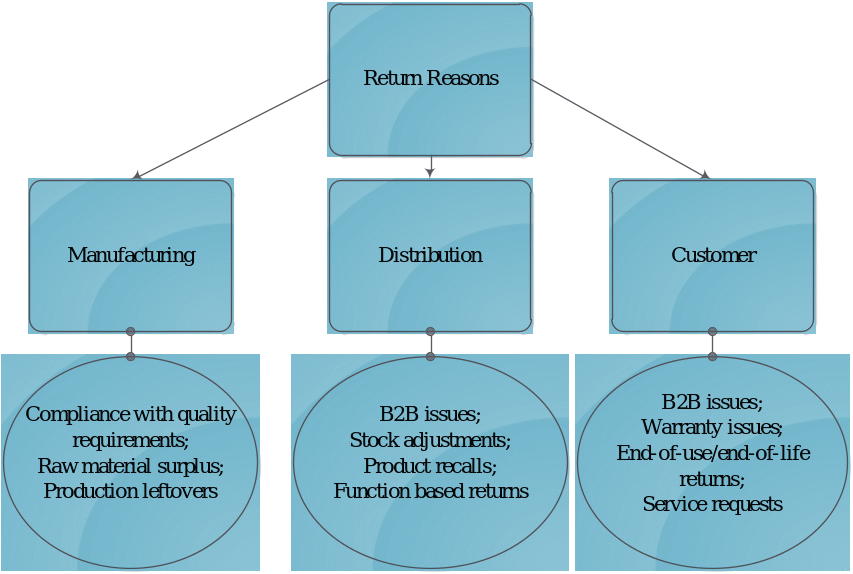
The Way Return Processes Are Carried Out
RL process comprises a complex set of activities flowing one after another. First, the product is collected, i.e. the customer brings it to the recovery point. At the recovery point, the product is carefully inspected in order to assess its functional characteristics and quality parameters. After that, the recovery team decides upon the procedures required to be performed. Hence, some products might be immediately sent to the market, while others are assigned for reprocessing. The latter alternative implies various operations such as repair, remanufacturing, refurbishment, etc. A detailed analysis of these operations will be provided later while discussing the place of RL in the PLC structure. On the whole, recovery processes can be divided into two groups: direct and processed recovery. The former group implies immediate resale and redistribution, while the latter comprises the operations enumerated above (Dekker et al., 2013). The figure represented below illustrates the recovery processes structure and the associated operations.
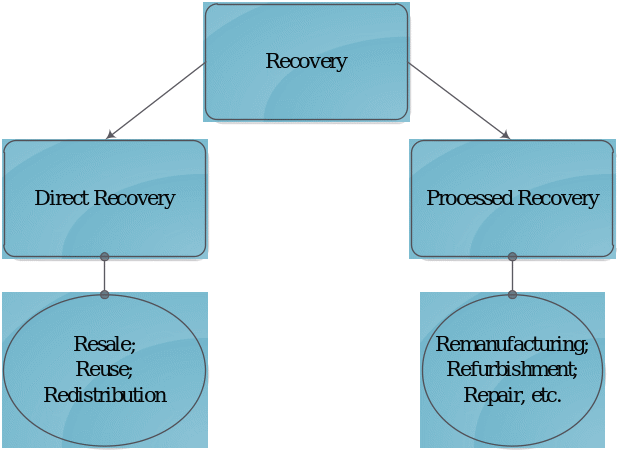
The required recovery operation depends on the type of the product. Thus, practice shows that large products such as buildings and installations are commonly sent for refurbishment. Smaller products that can be broken down into parts and raw materials undergo the recycling process. Energy products, in their turn, are assigned for incineration (Dekker et al., 2013).
Types of Returned Products and Their Characteristics
Products that participate in RL processes possess the specific characteristics that need to be analyzed in order to acquire a better understanding of the RL functioning. Hence, Dekker et al. (2013) suggest distinguishing three key areas of product characteristics: product composition, its deterioration, and use pattern. Product composition determines the prospects of RL processes that can be carried out. Thus, it implies the number of details composing the product structure or the constituting raw materials. The scope of components, as well as the manner they are put together, affects the recovery process from different standpoints, including the economic perspective.
Deterioration characteristics are likewise critical as they determine the length of the life cycle of the product’s functioning and its economic value. While evaluating the deterioration parameters of a product, it is also essential to consider the homogeneity of deterioration. In other words, it is necessary to evaluate whether product parts are likely to age equally, or some of them will show longer life cycle than others. In the former case, the product is apt to be remanufactured, whereas the latter case implies the prospects of its reuse (Dekker et al., 2013).
Lastly, a product use pattern comprises the characteristic associated with product use duration, location, and use intensity. All these external factors are likely to have a significant impact on the length of the product functioning. Thus, for instance, those products that are going to be used every day are more likely to need a soon recovery than those that are going to be exploited every once in a while. Dekker et al. (2013) suggest that according to the characteristics that products possess within these three dimensions, they might be subdivided into six major categories: consumer products, industrial products, packaging and distribution products, spare parts, oils and chemicals, and civil objects. They likewise add that there are also materials that cannot be referred to any of the enumerated groups, i.e. glass, scraps, pulp, etc. Putting it more specifically, consumer products comprise such goods as furniture and clothes, while industrial products include professional equipment. Civil objects, in their turn, are composed of such products as buildings, roads, and bridges, to name but a few. The figure presented below provides a summarized illustration of RL product types.
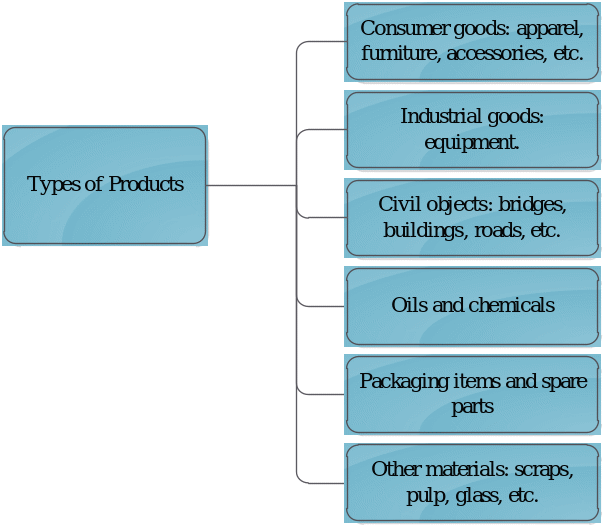
Key Actors of RL Process
Dyckhoff, Lackes, and Reese (2004) suggest distinguishing three major transformation phases that a product covers within a closed loop system: production, consumption, and reduction that are related to such procedures as distribution, collection, and induction. Each transformation phase is essentially associated with one of the actor groups: consumers, disposers, or providers. Thus, product distribution is performed at the point of sale that brings together providers and consumers. Product collection is carried out at the point of return that connects consumers and disposers. Product induction, in its turn, takes place at the point of re-entry or exit depending on particular PLC. Such operation as production, consumption, and reduction should be viewed as transitional milestones of the general transformation process. The figure below illustrates the described interconnections.
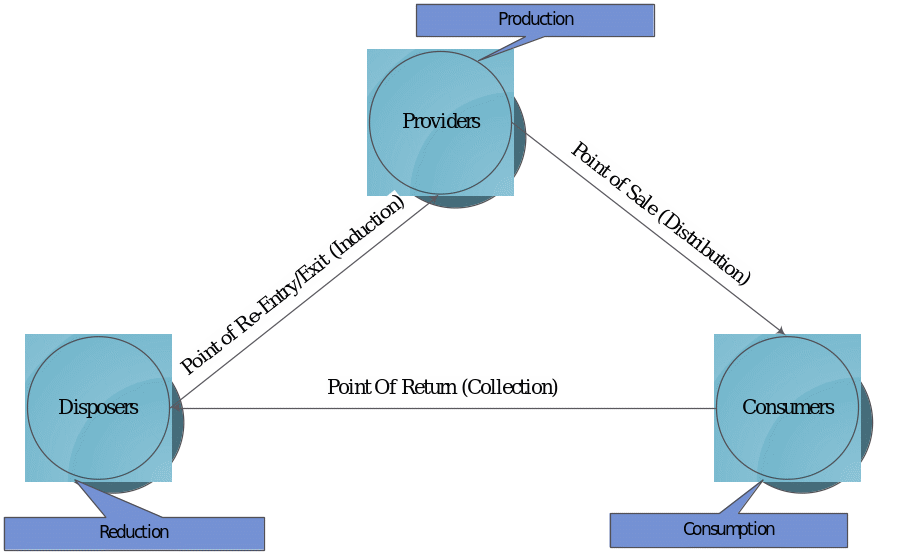
As it might be seen in the figure above, producer agent is associated with the production phase. In this phase, the product is manufactured using various raw materials and preliminary products from other systems such as economic. Provider agents might be represented by essential producers, retailers, logistic organizations, or wholesalers. Consumer agent, in its turn, is associated with the consumption phase. In this phase, product value is naturally lowered – some of its parts might require refurbishment, recycling, or manufacturing for it to be appropriate for further utilization. Consumer agents might be represented by public or private customers. The last agent, disposers, is associated with the reduction phase. In this phase, the product is exposed to all the RL procedures previously discussed (Dyckhoff et al., 2004).
Dekker et al. (2013) propose another agent classification. Thus, they suggest distinguishing the key actors in accordance with the functions they perform within the RL paradigm. According to their classification, it is essential to point out three major groups: actors that are associated with forward supply chain, those that participate in the specialized reverse chain, and opportunistic players. The former group comprises such parties as suppliers, retailers, wholesalers, and manufacturers. The group of actors associated with specialized reverse chain is composed of jobbers and recycling specialists. The latter group includes charity organizations.
According to another classification that is likewise proposed by Dekker et al. (2013), actors can be divided on the ground of the levels of responsibility: managerial and executive. In this case, the managerial level will be represented by the organizer parties, i.e. governmental institutions, Original Equipment Manufacturers (OEMs), wholesalers, and retailers. The executive level, in its turn, will be divided into three sub-levels: collecting, processing, and re-distributing. Collecting functions are assigned to Layered Service Providers (LSPs), third parties, jobbers, and municipality. Processing obligations are carried out by OEMs and jobbers, while the re-distributing function is performed retailers, wholesalers, and OEMs. The figure represented below illustrates the RL functional levels and associated parties.
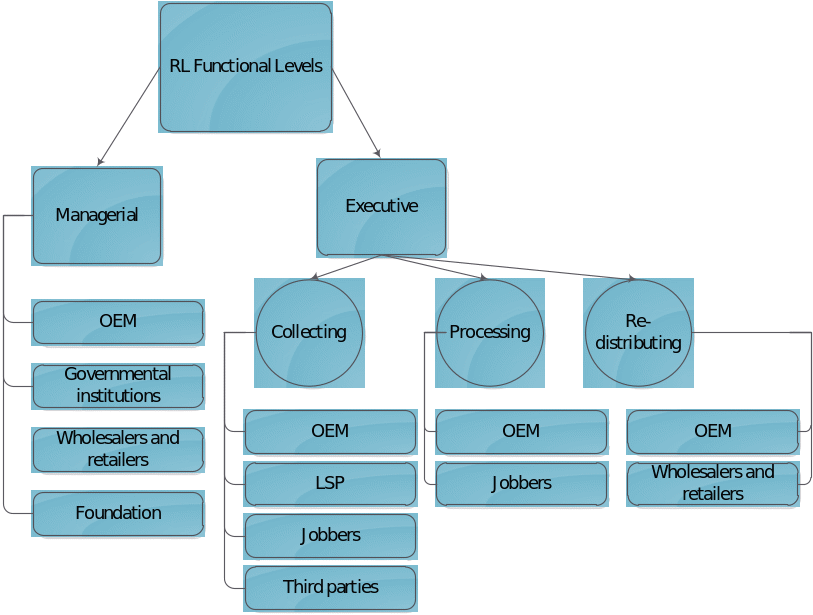
As it might be seen in the figure above, the specificity of RL functional structure resides in the fact that one and the same actor can appear at different functional levels and carry out both managerial and executive operations.
RL in the Context of Product Life Cycle (PLC)
In order to acquire a better understanding of RL processes, it is essential to define their place in the general life cycle of a product. As a rule, PLC comprises three major stages: the beginning of life (BOL), the middle of life (MOL), and the end of life (EOL). Each stage is characterized by the relevant operations that the product is exposed to. Thus, the BOL phase implies product development, production, and its distribution. The MOL phase includes such procedures as utilization, service, and repair. Finally, it is the EOL phase that is closely interconnected with RL operations. The figure below illustrates the PLC phases and the associated procedures.
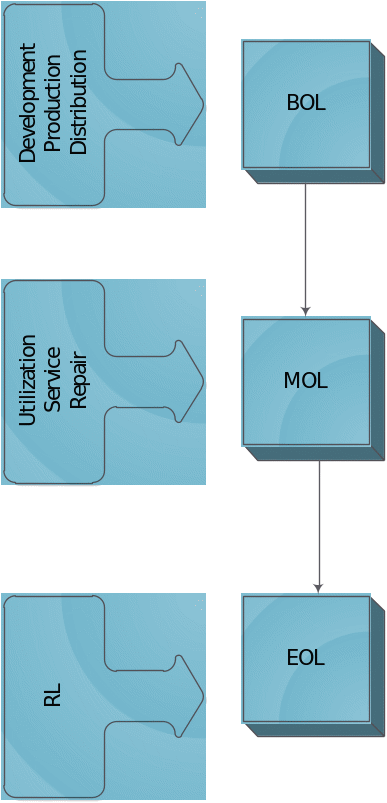
As it might be seen from the figure above, the role of RL assists in closing the loop between the two phases of PLC: EOL and BOL. The potential course of events might flow within two scenarios. First, the product can return to the BOL stage, or it can be finally sent to disposal. Likewise, it should be mentioned that it would be inaccurate to define the EOL stage as RL without providing the necessary clarifications. Thus, RL comprises a large scope of activities such as disposal, recycling, remanufacturing, refurbishing and reuse (Hesselbach & Herrmann, 2011). The illustration of the EOL phase is represented below.
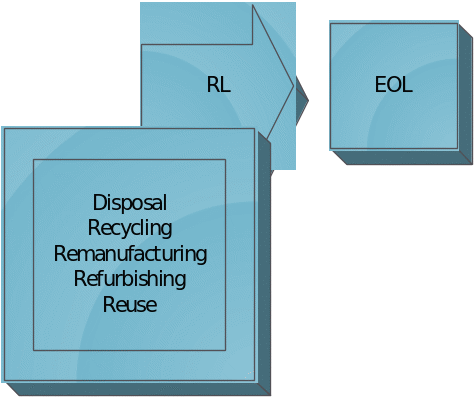
Each activity included in the RL scope has its specificity and performs a special role in adding value to the PLC. All the options except for the product disposal assist in performing the closed-loop SC within which PLC represents an infinite flow of a product. Some of the processes allow the product to maintain its original functionally as it returns to the BOL stage. Thus, for instance, product reuse means that a product or its parts are redistributed without undergoing significant changes. Refurbishing implies the same procedure except for the fact that some of the product parts or the entire product is overhauled. Opposite to the remanufacturing, the two activities do not imply the replacement of the product parts. The former process is aimed at making a new product that would meet the quality requirements and the functional scope of the old one by replacing some of its components. The last procedure that needs to be discussed is recycling. It does not target to preserve the entire product that can be sent to the BOL stage. Instead, it aims to break it down into separate parts or raw materials that can be further used for manufacturing a new product. It is essential to note that the recipients might differ from product to product. Thus, for instance, the raw materials extracted at the recycling stage might be dispatched to the manufacturer. Likewise, the refurbished product might be sent back to its initial owner or resold through the relevant retailers (Hesselbach & Herrmann, 2011).
Infinite PLC Examples
In order to summarize the analysis of RL in SCM and illustrate its functioning, it is proposed to examine some examples of infinite PLCs. Hence, let us observe the RL process flow on the example of two products: a piece of consumer goods and a packaging item. Thus, the figure represented below depicts the infinite PLCs of an armchair.

As it might be seen in the figure above RL processes is a stepping stone between the consumption stage and product final disposal or its BOL stage. The figure offers different scenarios of product returns and illustrates the relevant outcomes. Hence, for instance, a consumer might return an armchair because it needs some repair services. In this case, second market actors will either refurbish or repair the armchair and return it back for further reuse (see the green arrows in Fig. 8).
Another scenario implies that consumers have changed their minds and return the product using the guarantee option. In this case, the RL specialists will have to evaluate the product’s condition and decide whether any operations need to be performed. Thus, the armchair might be refurbished or repaired and returned to distributors for further reuse. It might likewise be remanufactured so that some of its parts are replaced. In case the product condition is appropriate, it will be sent directly to the distributor. Under any conditions, the armchair will continue its lifecycle (see the red arrows in Fig. 8).
The third scenario implies that the consumers return the armchair on the ground of the end-of-use or end-of-life reasons. In this case, RL specialists might perform all the operations described in the previous paragraph except for the direct dispatch to the distributor. Additionally, the armchair might be in an unfixable condition so that it will be recycled and sent to the final disposal (see the blue arrows in Fig. 8).
It might be perceived that the illustration does not show the flow of actions in case of the return associated with B2B reasons. In the meantime, under this scenario, the product will make the same way as in the case of the return associated with either warranty issues or service request (see the green and red arrows in Fig. 8).the provided illustration of eternal PLC can be relevant to almost any type of consumer goods. A different operational flow might be found in container LC that is illustrated in the figure below.
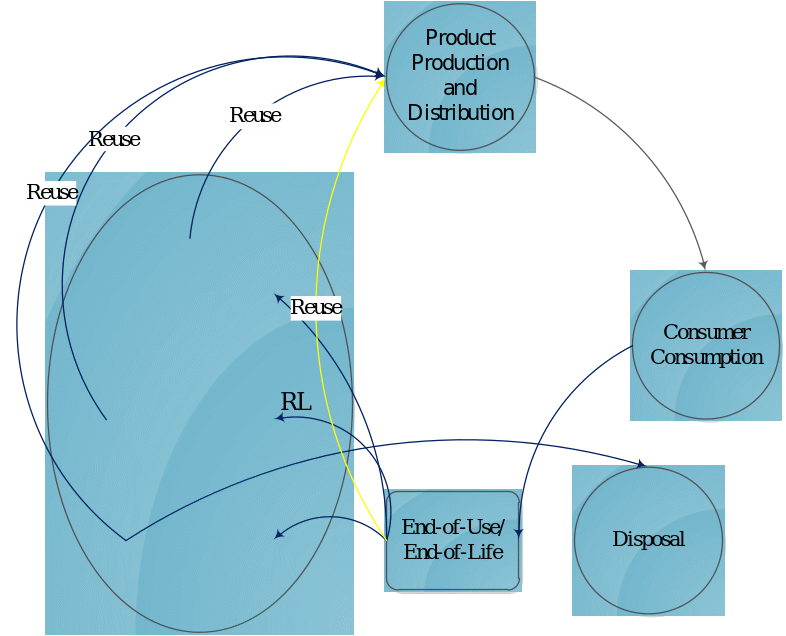
As it might be seen in the figure above, the operational flow is less complicated with packaging containers than in the case of consumer goods. Thus, the most typical scenario implies that the product is returned because it is either no longer used or its condition does not allow for further exploitation.
Even though the illustration shows different alternatives of RL processes including remanufacturing and repair, Blumberg (2004) notes that in most cases these products are recycled or dispatched directly to the distributor for further reuse. Less frequently, they can be refurbished if there are some minor problems with their functional characteristics. It is also necessary to point out that many companies now shift to the use of natural materials for container production so that little waste is sent to the disposal phase as most of the product content is recycled, and the raw material is sent for remanufacturing (Voortman, 2004).
Both illustrations show how RL procedures help to optimize the operation flow of the products. Thus, most of the products are dispatched for further reuse, while only a few scenarios imply the final disposal.
Latest Trends in RL
RL is an emerging branch of logistics. Thus, new alternatives and solutions are constantly designed in order to optimize its functioning. Researchers note that the appearance of new trends in RL is mainly determined by the rapid pace of technology development and the strengthening power of environmental legislation. Thus, Antonyová, Antony, and Soewito (2016) suggest distinguishing three key areas of RL improvement that need to be discussed: e-waste logistics, natural materials, and customer involvement.
The interest in e-waste and the effective methods of its reduction is explained by the growing number of computer technologies that enter the market. Thus, researchers are mainly focused on evaluating the scope of e-waste participating in RL chains and searching for alternative solutions for its recycling. The specificity of e-waste resides in its high value. Hence, many companies try to avoid its final disposal at any cost preferring such procedures as refurbishment and repair. Meanwhile, electronic inputs have a different structure than common waste, and special qualifications are required to perform a high-quality repair service. Antonyová et al. (2016) refer to the example of Chinese RL management that proposes processing electronic materials with the help of specially organized companies and groups. Otherwise stated, the current trend resides in finding solutions associated with the separation of the e-waste from other offcuts due to the specific character of the former. Thus, new actors of RL operations appear in the relevant market which shows that RL structure becomes more diverse and complex.
Another trend that should be pointed out is the shift to the use of natural materials. This tendency is particularly observable in the civil building sector. According to Antonyová et al. (2016), waste management in this sector is rather challenging as it is essential to cope with numerous problems such as inappropriate material storage and order errors. Wrong evaluation of the waste recycling expenses leads to considerable financial losses. The implementation of natural materials, in this case, appears to be an effective solution to minimizing the waste-related expenses and optimizing recycling processes.
The last trend that Antonyová et al. (2016) emphasize is the increasing importance of customer involvement. This phenomenon is determined by the need to enhance the role of consumers in the collection stage. In other words, RL operations might be potentially realized through supermarkets that can constitute the new element of SC offering recycling options to consumers. This solution is currently at the development stage, and consistent research and analysis are required before it can be implemented.
Among other current tendencies in the RL sector, Antonyová et al. (2016) also point out the importance of research activity as a critical element of planning RL strategies. Thus, the authors note that more organizations are concerned about carrying out preliminary studies to ensure accurate evaluation of the scope of RL input and output. Additionally, they point out the growing awareness of the need for implementing new technologies in the RL operations to make them more productive and cost-effective. The researchers also put an emphasis on the strengthening role of the green image that makes producers exhibit additional responsibility for the entire PLC.
A less optimistic assessment of the RL sector is provided by Burnson (2014) who believes that despite the awareness of RL importance, organizations still do not have consistent RL strategies that would allow for a sustainable operation flow. The author assumes that the key problem resides in the fact that companies tend to adopt forward logistic techniques for performing RL operations neglecting, in such a manner, the specificity of reverse chains. Therefore, Burnson (2014) points out that the main current trend in RL is designing consistent return management strategies. Burnson (2014) suggests that such strategies will let producers “cut the cut operational cost while increasing sales and securing customer loyalty” (para. 8). The author also points out the increasing importance of RL data management. Thus, organizations need to implement new data collection and analysis tools in order to enhance their product return operations and allow for quick product transporting to secondary markets.
Another peculiar tendency that Burnson (2014) points out is the growing awareness of return value. The author explains that companies begin realizing that return can turn out to be another sale; thus, they start encouraging returns by providing consumers with free return shipments and other advantageous options. Burnson (2014) believes that modern RL targets not only to process returns and cut the waste expenses but to build up long-term consumer loyalty and increase sales.
Conclusion
The review of the RL structure and the associated concepts has helped to understand the way RL assists in moving items from the point of consumption to the point of origin in an effective and profitable manner. Therefore, it might be summarized that RL is mainly aimed at assisting companies in raising the customer satisfaction and value recovery. Additionally, it helps to ensure strategic alliances and compatibility with the relevant environmental legislations. The research review has also revealed that the improvement of RL operations allows discovering and implementing new technologies that help to optimize the performance of SCM in general.
Reference List
Antonyová, A., Antony, P., & Soewito, B. (2016). Logistics management: new trends in the reverse logistics. Journal of Physics: Conference Series, 710(1), 218-228.
Blumberg, D.F. (2004). Introduction to management of reverse logistics and closed loop supply chain processes. Boca Raton, Florida: CRC Press.
Burnson, P. (2014). Improving reverse logistics with a returns management strategy. Logistics Management. Web.
Carter, C. R., & Ellram, L. M. (1998). Reverse logistics: A review of the literature and framework for future investigation. Journal of Business Logistics, 19(1), 85-102.
Christiansen, B. (2014). Handbook of research on effective marketing in contemporary globalism. Hershey, Pennsylvania: IGI Global.
Dekker, R., Fleischmann, M., Inderfurth, K., & Van Wassenhove, L. N. (2013). Reverse logistics: quantitative models for closed-loop supply chains. Berlin, Germany: Springer Science & Business Media.
Dyckhoff, H., Lackes, R., & Reese, J. (2004). Supply chain management and reverse logistics. Berlin, Germany: Springer Science & Business Media.
Hesselbach, J., & Herrmann, C. (2011). Glocalized Solutions for Sustainability in Manufacturing. Berlin, Germany: Springer Science & Business Media.
Murphy, P. (1986). A preliminary study of transportation and warehousing aspects of reverse distribution. Transportation Journal, 25(4), 12-21.
Ritchie, L., Burnes, B., Whittle, P., & Hey, R. (2000). The benefits of reverse logistics: the case of the Manchester Royal Infirmary Pharmacy. Supply Chain Management: An International Journal, 5(5), 226-234.
Rogers, D. S., & Tibben-Lembke, R. (2001). An examination of reverse logistics practices. Journal of Business Logistics, 22(2), 129-148.
Thierry, M., Salomon, M., Van Nunen, J., & Van Wassenhove, L. (1995). Strategic issues in product recovery management. California Management Review, 37(2), 114-135.
Voortman, C. (2004). Global logistics management. Cape Town, South Africa: Juta and Company.